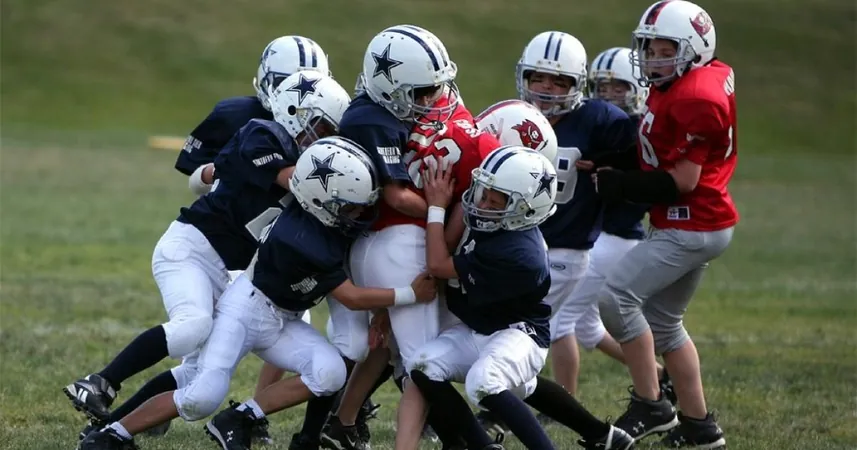
Groundbreaking MRI Study Aims to Revolutionize Understanding of Head Injuries in Young Athletes
2025-01-14
Author: Siti
Introduction
In an exciting new effort, researchers at The Podium Institute for Sports Medicine and Technology—affiliated with Oxford University’s Institute of Biomedical Engineering—have scanned their first patient as part of a pioneering study examining the effects of head injuries on youth athletes. This research is particularly timely, given the rising concern over the long-term repercussions of traumatic brain injuries (TBIs) in young sports participants.
Shifting Paradigm: MRI vs CT Scans
Traditionally, computed tomography (CT) scans have been preferred for diagnosing head injuries in children presenting to emergency rooms. However, this innovative study is shifting the paradigm by utilizing advanced MRI techniques, which allow for a more detailed analysis of the brain's condition post-injury. Experts intend to explore numerous dimensions of brain damage, focusing on critical areas such as nerve fiber integrity, brain metabolism, and interregional functional connectivity.
Comprehensive Approach
Unique to this study is its comprehensive approach, which combines advanced imaging results with cognitive assessments and subjective reports from the young patients themselves. This integrated methodology aims to develop objective insights into recovery trajectories from both physiological and cognitive perspectives. The ultimate goal is to identify specific MRI biomarkers that could predict individual recovery paths, allowing for tailored interventions in the future.
Study Design and Participants
Over the next two and a half years, the study will encompass two groups of participants: 60 young athletes who regularly engage in contact sports—many of whom have suffered head injuries—and 60 control subjects who do not participate in such activities. This comparison will be crucial in elucidating the disparities in recovery and long-term outcomes between athletes and non-athletes.
Addressing Unanswered Questions
There are still many unanswered questions regarding the long-term effects of head injuries sustained during youth sports. However, the researchers are optimistic that their findings will have significant implications for the treatment and management of head trauma in young individuals.
Expert Insights
Tim Lawrence, a consultant pediatric neurosurgeon with the Nuffield Department of Clinical Neurosciences at Oxford University and a lead researcher on the project, expressed the urgency of addressing these issues. "With growing concern regarding a potential link between mild or repetitive traumatic brain injury and long-term cognitive difficulties or even early dementia, it is imperative to pinpoint the types of injuries that may pose a risk to young athletes," he stated.
Professor Constantin Coussios, Director of the Podium Institute, emphasized the transformative potential of this research. "We aspire to identify clinically relevant imaging markers that can turn this often-subtle condition into one that can be diagnosed with greater confidence. This could enable clinicians, parents, and coaches to better predict the recovery outcomes for injured children," he noted.
Conclusion
As this groundbreaking study progresses, it promises to shed much-needed light on the complex dynamics of head injuries in youth sports—an area where knowledge is not just crucial for improving recovery but could also enhance protective strategies for young athletes in the stadiums and fields worldwide. Stay tuned for updates as researchers delve deeper into this pressing issue that affects thousands of children every year!

 Brasil (PT)
Brasil (PT)
 Canada (EN)
Canada (EN)
 Chile (ES)
Chile (ES)
 Česko (CS)
Česko (CS)
 대한민국 (KO)
대한민국 (KO)
 España (ES)
España (ES)
 France (FR)
France (FR)
 Hong Kong (EN)
Hong Kong (EN)
 Italia (IT)
Italia (IT)
 日本 (JA)
日本 (JA)
 Magyarország (HU)
Magyarország (HU)
 Norge (NO)
Norge (NO)
 Polska (PL)
Polska (PL)
 Schweiz (DE)
Schweiz (DE)
 Singapore (EN)
Singapore (EN)
 Sverige (SV)
Sverige (SV)
 Suomi (FI)
Suomi (FI)
 Türkiye (TR)
Türkiye (TR)
 الإمارات العربية المتحدة (AR)
الإمارات العربية المتحدة (AR)